
Tüm dünya Koronavirüs salgını ile mücadele ederken geçtiğimiz aylarda Lübnan’ın başkenti Beyrut’ta çok büyük bir patlama meydana geldi. Patlamada 100’den fazla ölü 6.000’den fazla yaralı vardı. Kilometrelerce uzaklıktaki evlerin camlarını kıran , arabaları havaya uçuran ve kenti savaş alanına çeviren patlamadan sonra kentte çok büyük bir kaos yaşandı.
As the world was struggling with Covid, an enormous explosion in Beirut occured. There were over 100 casualties and thousands of people injured. Houses’ windows shattered kilometers away, cars blew up and there was a chaos like it is a warzone.
Öyle ki bu zor süreçte Lübnanlı sanatçı Hayat Nazer insanlara yardım etmek için sokaklara indi ve yıkılan evlerin enkazından çıkan cam, metal, tuğla gibi malzemeleri toplayarak evine götürdü. Yaşanan acı olay sanatçıya ilham olurken yaptığı eserle umut da verdi.
During these hard times, Lebanese artist Hayat Nazer, went to that area to help people. She collected shattered glasses, metal and brics to create an artwork that brings people hope.
Hayat Nazer ile Beyrut’ta yaşanan patlamadan sonra yaptığı heykelin hikayesini konuştuk.
We’ve discussed with Hayat about the situation in Beirut and the story behind her sculpture.
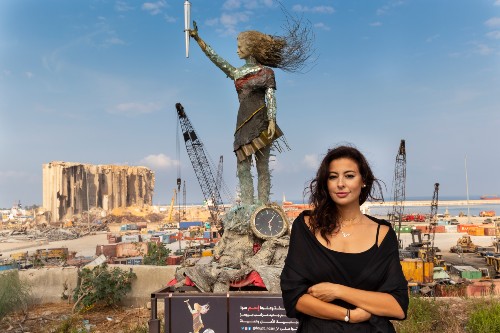
Fulden Karayel:
-Heykel yapma fikri nasıl oluştu?
- How did you get the idea to make a sculpture?
Hayat Nazer:
Patlamadan sonra o bölgedeki kırık camları temizlemek için sokaklara ve evlere gittim. Evleri gezerken bu kültüre ait bir fikir canlandı gözümde.
After the explosion, I’ve visited the streets and homes to clean up broken glasses. There I’ve got the idea of this culture.
FK:
-Heykel yapım süreci nasıldı? Hangi malzemeleri ve araçları kullandınız?
-How was the sculpture making process? What materials and tools did u use?
HN:
Kendimi tanıdığım için devrimin başından beri kırık bir şeyler gördüğüm zaman bunu onarmak, iyileştirmek ve yeniden oluşturma ihtiyacı duyuyorum. Yerleri temizlemek için insanların evlerine gitmeye başladım ve kırık camları atmak istemedim bu yüzden onları eve götürdüm. Yani her şey döngüsel. Hepsi sokaklardan.
I now know myself when I see something broken, I feel like fixing, healing and building it. When I was cleaning the floors, I didn’t want to throw away the broken glasses and so I took them back home. So it’s all upcycled. The materials are all from the streets.
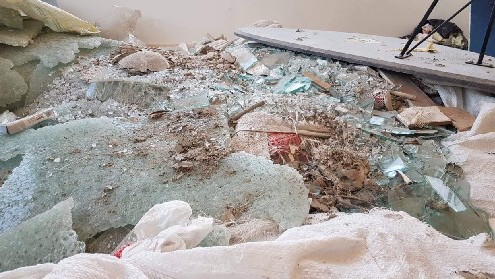
FK:
-Heykeli yaparken nasıl hissettiniz?
-How did you feel while creating the statue?
HN:
Beyrut'un yok olduğunu görmek ve her şeyin yok olduğunu görmek canımı acıtıyor. Bu yüzden yeniden inşa etmeye çalıştım. Molozları topladım, daha önce bir kadın hakkında heykel yapmaya başlamıştım Beyrut'un bir kadın olduğunu hissettim. Sokaklardan ve kırık evlerden malzeme topladım. Yaşanan olaylar bu kadının bir parçası olmalı dedim ve Beyrut'un bir kadın olduğunu hissettim. Ben de bu kültürü bu enkazla inşa etmeye başladım. Lübnan bayrağını taşımasını sağladım.
You’d know, it hurts seeing Beirut being destroyed, or just anything being destroyed. That’s why I tried to rebuild it. I’ve previously started making a sculpture of a woman before and I’ve felt like Beirut is a woman. When I was collecting the rubble I felt that these should be part of it, I felt that Beirut is a woman. So I’ve started building this culture with these debris. I made her carry the lebanese flag.
Dürüst olmak gerekirse patlamadan sonra insanların evlerine gidip çok fazla acı görmek ve insanlarla konuşmak çok duygusaldı. Bu yüzden çok ağırdı. Hiç kolay değildi. Hem ülkem adına ulusal bir seviyede, hem de kişisel olarak çok çok güçlü bir duygu içerisindeydim. Çok karışık duygular, acı keder ve bir miktar güç ve direnç duygularını yaşıyordum. Acı, keder ve her şey ve ayrıca bir miktar güç, bir o kadar da yeniden ayağa kalkma ve devam etme isteğini hissediyordum. Orada acıyı azaltmaya çalışmak, Devrimden etkilenen insanları, kendimi, şehrimi ve ülkemi iyileştirmek gibiydi. Bu kadının her ne kadar yüzünde bir yara izi olsa ve kırık parçalardan oluşsa da güzelliğini ve zerafetini korumak istedim çünkü Beyrut da tam olarak böyle.
To be honest, it was very emotional because of the explosion and going through the people’s homes, talking to them and feeling their pain is very heavy. I was both on a national level as it’s my country and also on a personal level as it was very strong feeling. I’ve had mixed feelings of pain and sorrow as much as power and the will to rise again and to persevere with so much pain. When I was trying to heal all those pain in the area, it feels like I’m healing myself, the people affected by The Revolution and rebuilding this woman from the debris is like rebuilding my city Beirut and my country. Although the women has a scar on her face and is built of broken pieces I wanted the woman to keep the beauty and elegance, because she is what Beirut is.
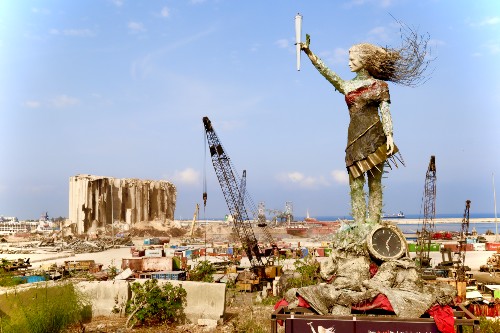
FK:
-Heykel neyi sembolize ediyor?
-What does the statue symbolize?
HN:
Hem gerçek olan acıyı, gerçek olan yıkımı göstermek hem de insanlara umut ve güç vermek istedim çünkü umut ve güç olmasaydı ve yükselme iradesi olmadan öleceğiz. Bu yıl çok ağır, hepimiz için çok ağır oldu ve biraz morale ihtiyacımız var. Bu yüzden gerçeği göstermek ve aynı zamanda insanlara biraz umut da vermek istedim.
I didn’t want to just show the destruction, but also give people hope and power to get back up. This year has been too hard on all of us and we need to raise morals, that’s why I wanted to both show the reality and also make people feel hopeful.
FK:
-Türkiye'de hiç sanat eseriniz var mı?
-Do you have any artworks in Turkey?
HN:
Türkiye’de hiç eserim yok. Bunu yapmak da çok isterim. Sanatımı tabii ki tüm dünyaya yaymayı ve insanlara sanatımın altında yatan mesajları iletmeyi çok istiyorum. Her eserim mutlaka bir mesaj verir. Gerçekten yapmak istediğim şey sokak sanatını sürdürmek ve bunu insanlar için yapıyorum. Bana para kazandırmasa da herkese, fakire zengine, eğitimli olana veya olmayana ulaşabiliyor ve bu beni tatmin ediyor. Sokak sanatı insanlar için ücretsiz ve bunu seviyorum çünkü dünyayı değiştiriyor.
No, I don’t have any artwork in Turkey but I’d love to have that. I would love to spread my art all over the world by exhibitions. Of course I’d like to share the messages I’m giving through my art. I really would like to keep doing street art because it is free for the public. It doesn’t make me money but for me but it satisfies as it reaches to the poor and the rich, the educated or that are not educated. That’s why I do and love street art, to make a change in the world.

FK:
-Nerede yaşıyorsunuz? Kaç yıldır heykel yapıyorsunuz?
-Where do you live? How long have been sculpting?
HN:
Aslen Lübnan'ın kuzeyindenim ama bir yıl kadar önce Beyrut'a taşındım ve şimdi Beyrut’ta yaşıyorum. Kasımda ilk heykelimi Şehitler Meydanında yaptım. Bazı hükümet yanlısı insanlar gelip çadırlarımızı yıktılar çünkü devrimi sona erdirmek istediler ve bizi engellemek istediler. Benim de kırık çadırlardan bir heykel yapma fikrim vardı. Hayatımda daha önce hiç heykel yapmamıştım ama isteğim ve inancım çok yüksekti. Sokağa çıktım ve insanlar bana yardım etmeye başladı ve bana bu bir mucizeydi çünkü nasıl yapılacağını bilmiyordum. Benim ekipmanım ve param da yoktu ama yaptık. Bu yıl ilk yılım olsa da birçok heykel yaptım. İlki Anka kuşuydu ve sonrasında tencerelerden bir ağaç yaptım, göz yaşartıcı gaz bombalarından bir kalp yaptım. Ve bir de plastik ve korona hakkında yapıyordum. Henüz bitiremeden patlama oldu, ama bir gün bitecek. Yani bu daha ilk yılım ve Devrim sırasında insanlardan ilham aldım ve ilk heykellerimi hayata geçirdim.
Actually I am from the north of Lebanon but last year I moved to Beirut. So I live in Beirut now. You may have seen in articles that I made my first sculpture in Martyr Square. Some pro-government people came over and they broke our tents to end the revolution and they wanted to stop us. That’s when I had the idea to make a sculpture from the broken tents. I didn’t do any sculpture before, so I was unsure what to do. I also didn’t have any equipment or money but then when I was collecting the debris of tents, a miracle happened and people started to help me, so we did it. I did many sculpture in this first year. The first one was the Phoenix, then I made a tree out of saucepans, an heart from the tear gas bombs. I was working on another sculpture about plastic and coronavirus but I couldn’t finish it because of the explosion. I’ll finish that someday.
FK:
-Bir sergi açtınız mı? Eserlerinizi nasıl görebiliriz?
-Have you opened an exhibition? How can we see your artworks?
HN:
Bunu yapmak çok isterim ki bunun için fonum yok. Tüm paramı sokak sanatı yapmak için harcadım ama bir sergi yapmam gerekiyor. Bu sanat eserlerini korumak için kendi galerime sahip olmalıyım çünkü örneğin, Phoenix adlı eserimi bazı hükümet yanlısı insanlar yok etti, yaktılar. Phoenix’in kanatlarını parçaladılar ve kafasını kırdılar ve kafasını da çaldılar. Yani artık Phoenix yok. Benim yaptığım Devrimin kalbine de benzin attılar, yakmak istediler. Özgürlük Anıtı'ndaki kadın heykelini veya liman ya da Beyrut heykelini kırabileceklerinden çok endişelendim çünkü ona bir isim vermedim. İnsanların seçmesi için adını açık bıraktım.
I’d love to make that but I don’t have any funding for that. I’ve spent all of my money to do street art, but I know that I have to do one. I need to have my own gallery to protect these artworks because for example Phoenix was destroyed by pro-government people. They destroyed its wings and stole it’s head. So there is no Phoenix now. The heart of the Revolution, they threw gasoline over it. I was very worried that they might break the statue of the woman at the port. The statue of liberty or the statue of the port of Beirut were the names I thought but didn’t name it and wanted people to choose a name for it.
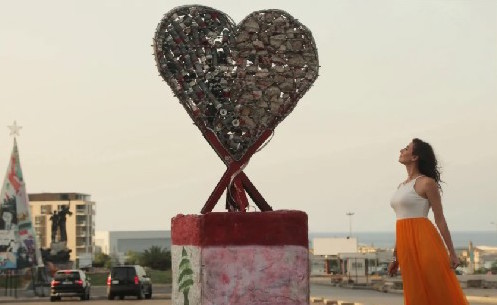
Hayat Nazer’in diğer heykellerini de şöyle sıralayabiliriz;
Hayat Nazer’s other scupltures:
- Kırık ayna tutan devrimin yumruğudur sonra kırıldı.
- The fist of revolution holding a broken mirror
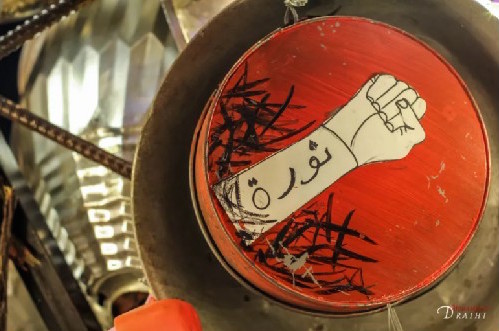
- Meşale. 17 Ekim’de Lübnan'ın her bölgesinden gelen protestocuların taşıdığı tüm meşaleleri temsil ediyordu, sonra elindeki meşaleyi limandaki büyük meşaleyi yakmak için çıkardığımda eli boştu ben de onu taşımasını sağladım.
- The Torch, because of the event on October 17th and the torch represents all the torches carried by protesters coming from all areas of lebanon. When I took the torch from her hand to light the big torch, it was empty so I made her carry that.
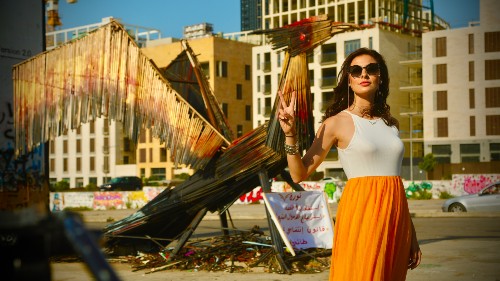
- Lübnan bayrağı ertesi gün, rüzgar bayrağı uçurdu, bu yüzden sadece ona benzeyen sopayı taşıyordu.
- The Lebanese Flag. The flag was blown away by the wind the next day, so it is holding only the stick of the flag.
- Kılıç benzeri bir sopa
- The sword-like stick
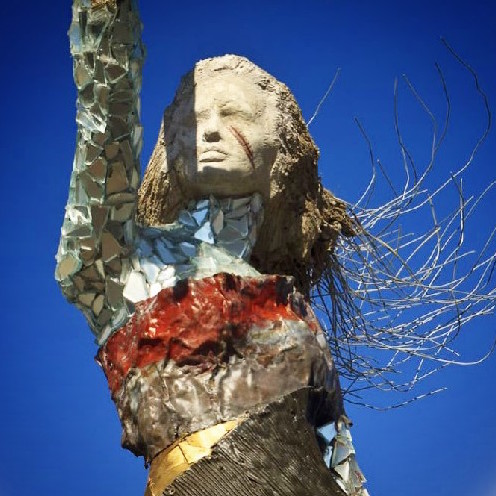
Yazı: Fulden Karayel
Çeviri: Doğuhan Okumuş
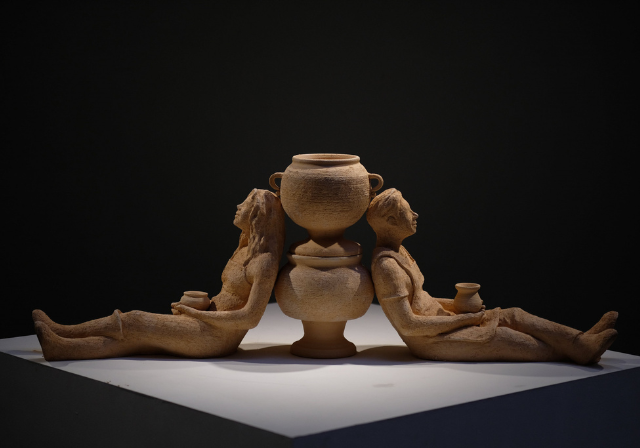 8 gün önce
8 gün önce
Sınırlar Var mıydı, Yoksa Biz mi Çizdik? Gelin BASE 2025'te Karar Verin!
 bir ay önce
bir ay önce
Didim'de On Sanatçı, Beş Gün: Anda Kalmak İçin Ne Yapmalı?
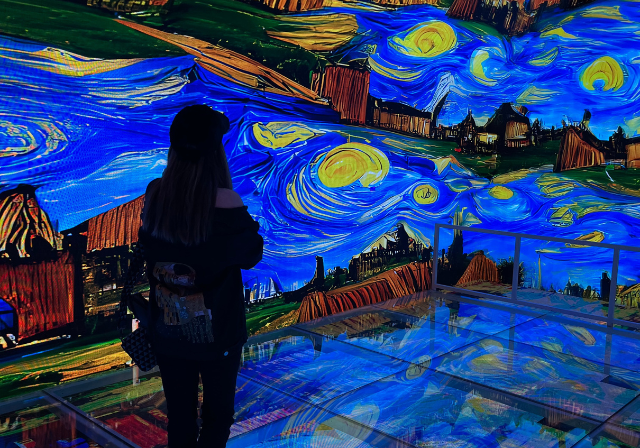 bir ay önce
bir ay önce
Van Gogh'un Çok Boyutlu Dijital Rönesansına Bir de Bu Açıdan Bakın
 2 ay önce
2 ay önce
Şehrin Ruhunu Bu Festivalde Keşfedin: 212 Photography Istanbul
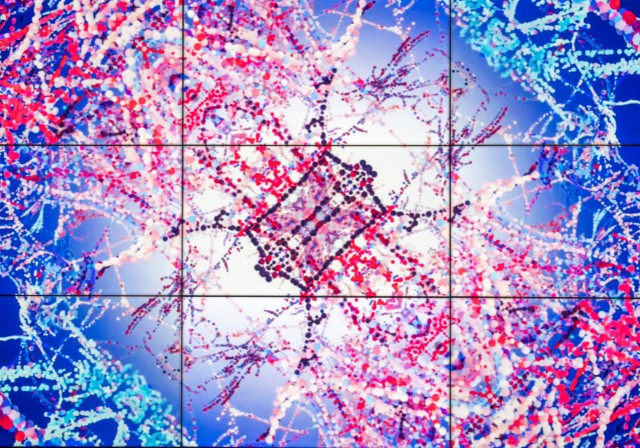 6 ay önce
6 ay önce
Hiçbir Şeye Şaşırmamak, Gerçekten Bir Sanat Mıdır?